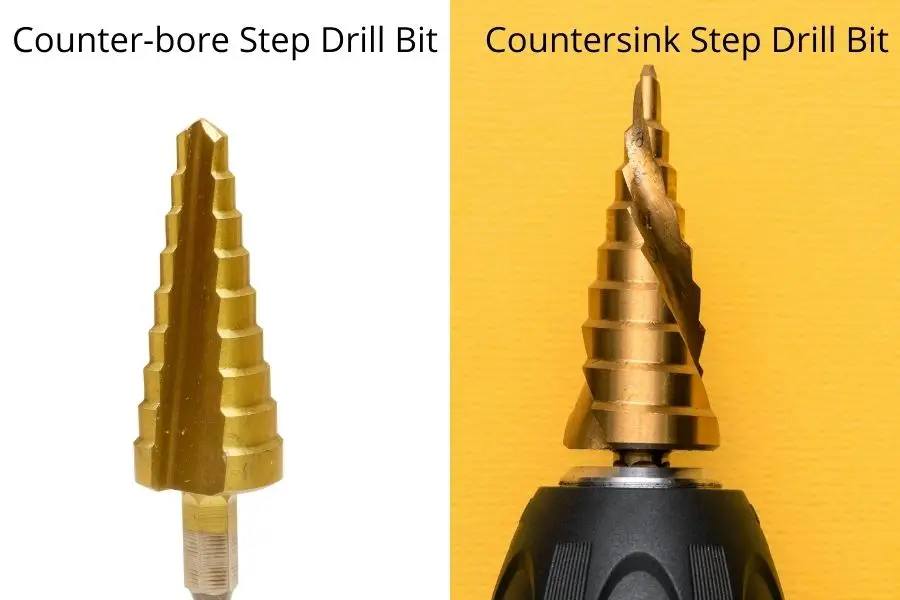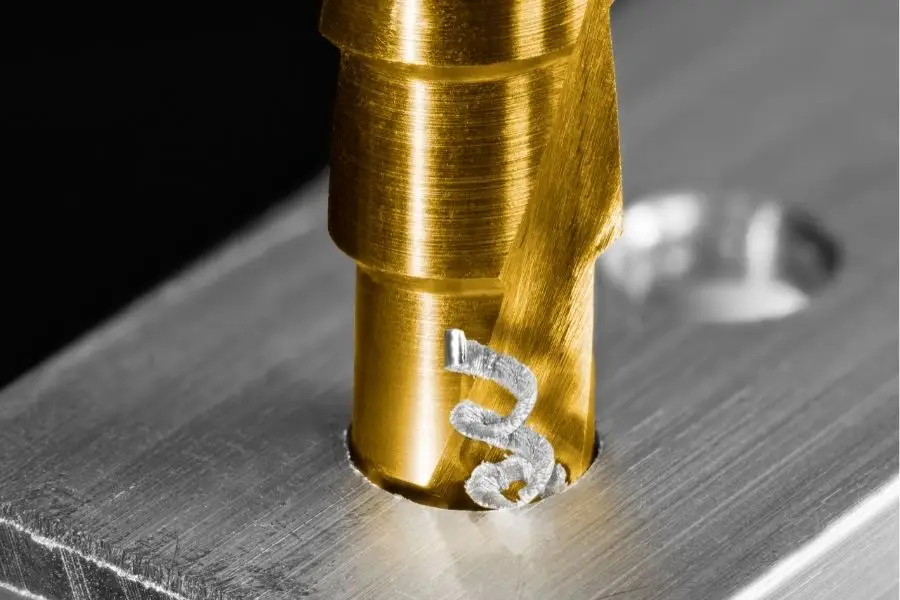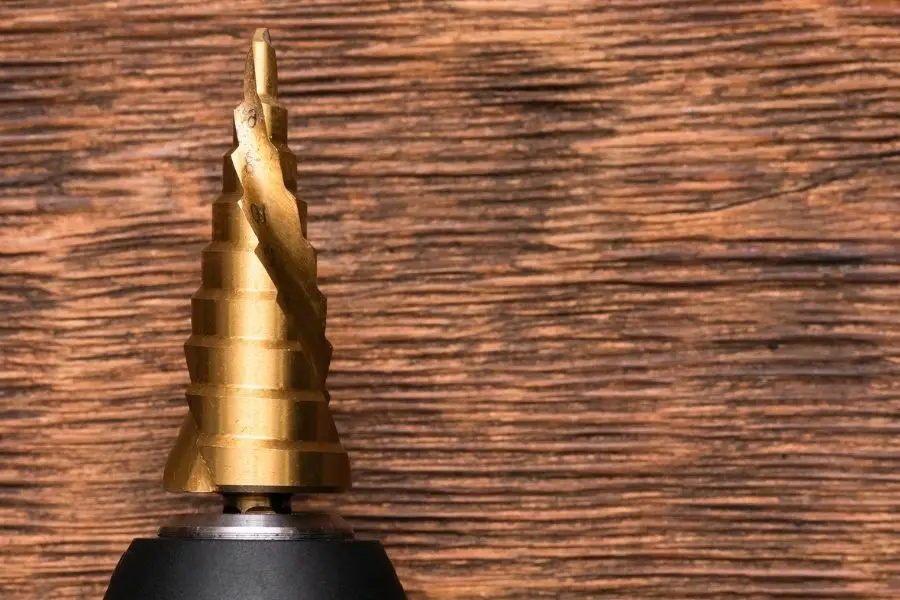If you are new to the world of DIY, you must be intrigued by the distinctly shaped step drill bits. You must wonder how you can use a step drill bit. Once you are done reading this article you will be convinced to add step drill bits to your toolbox.
When I first came across step drill bits I was actually quite confused about their use. Once I started looking into their uses I was really excited to invest in my own set of step drill bits. With experience, I have come to appreciate step drill bits even more with their multitude of uses.
If you are new to step drill bits, this article will answer each and every question in your mind.
How to use a step drill bit? You will use a step drill bit just like another drill bit with an exception of its purpose of use. For drilling with a step drill bit use a center punch to first mark the center. Now drill steadily with firm pressure. Step drill bits only work with thin metal sheets and can make holes of different sizes depending on the number of steps in your drill bit. You can also use it to enlarge or deburr an existing hole.
With a tool as versatile as a step drill bit there is a lot to learn once you start.
My main motivation behind writing this article is the fact that I myself struggled when looking for accurate information and detailed instructions regarding the use of a step drill bit. I have summed up all I learned through my experience of working with step drill bits in this article.
What is a Step Drill Bit?
A step drill bit is a conical shape drill bit to make different size holes with one bit. It has multiple levels with increasing diameters from tip to end. It has a sharp groove at one side which acts as the cutting edge. The step drill bit is also used to enlarge or deburr holes. This drill bit is used particularly for metals but can also work with wood, plastic, etc.

A step drill bit with a straight flute is called a counter-bore step drill bit while a step drill bit with a twisted flute is called a countersink step drill bit. The flute or the groove profile serves as a channel system for collection and chip removal during drilling.
I have found the step drill bit to be a valuable tool with its ability to replace numerous twist bits, deburrers, and reamers. There are a number of reasons you should use a step drill bit for drilling into sheet metals.
I have compiled a list of reasons I recommend every DIY enthusiast to add step drill bits to their toolbox.
- Multiple Diameters: With multiple diameters, a step drill bit saves you from the hassle of changing drill bits when you need to drill a lot of holes of different sizes. You can use a step drill bit to drill holes of different diameters.
- Selt-tapping tip: Step drill bits have self-tapping tips, which allow you to drill without drilling a pilot hole in thin materials.
- Flute: Flute on a step drill bit allows for easy removal of waste materials which prevents clogging as well as heating up of the drill bit.
- Reaming: Step drill bit gives you smooth edges on the holes instantly thus eliminating the need for a reamer.
- Deburring: You can also use a step drill bit to deburr the hole you have drilled by lightly touching each side of the hole with bevel of the next step.
And although step drill bits have a range of benefits, there are a few downsides as well.
- Sharpening step drill bits is actually really difficult. Even though you will find a number of sharpening kits for step drill bits on the internet, they need you to have a steady hand and experience.
- Since most step drill bits are 1/4″ thick they only work on thin materials.
- Step drill bits tend to be more expensive than normal drill bits.
- Even one damaged step in a step drill bit means that you will either have to replace it or just use it up to the damaged step.
What are Step Drill Bits Used for?

Step drill bits always stood out to me due to the fact that they can be used for a variety of jobs as opposed to other drill bits that are usually used for drilling holes only. I have listed down some of the common ways you can use a step drill bit.
Drilling Sheet Metals:
The first and foremost way you can use a step drill bit is to drill holes in sheet metals with thickness less than 1/4″.
If you have ever tried a normal twist bit to drill through thin metal you would know the kind of mess it creates. Step bits don’t have a twist, so they’re great for drilling through sheet metal and other thin, rigid materials.
They shave off material slowly and make progressively larger holes as you go from step to step. They also make a nice chamfered/beveled edge to the hole.
Drilling Carbon Fiber:
Carbon fiber is one of those materials which need to be handled with a lot of care while drilling holes. You can use a step drill bit to drill a hole in carbon fiber without damaging it. For a detailed step-by-step guide on drilling carbon fiber, you can check out my article here.
Drilling Plastics:
I have found step drill bits to be my first choice for drilling into plastics. You can use a step drill bit for getting smooth holes in plastic without having to worry about any damage to the material. In addition to plastics, step drill bits are also great to use on other soft materials.
Enlarging Holes:
Besides drilling new holes, you can also use a step drill bit to enlarge existing holes. Normally enlarging an already drilled hole can become quite problematic. But if the drilled hole is smaller than your step drill bit, you can use a step drill bit to enlarge it.
Deburring Holes:
Usually when you drill you end up with hole sides that can hurt you. Normally a rat tile file or another tool is used for deburring. You can also use your step drill bit for deburring a hole. Simply use the edge of the next step of your drill bit for deburring.
Knock out Holes:
If you do not have a knockout punch set, you can use a step drill bit to drill knockout holes. An added advantage of using a step drill bit for drilling knock-out holes is that you do not have to deal with metal shavings flying around.
How to Use a Step Drill Bit?

If you are trying to drill a hole with a step drill bit, I have compiled the list of steps you need to follow.
1. Take Safety Precautions:
The first step for any drilling project is to take the necessary safety precautions. Wear your safety goggles and work gloves to prevent any metal shavings from hurting you.
My favorite list of safety gear. You may not need all of them.
1. Dewalt Safety Glasses
2. Latex Double Coated work gloves
3. 3M professional Dust Respirator
4. Dewalt Industrial Grade Ear Protection
5. 3M Hard Hat
6. Caterpillar Steel Toe Industrial Boot
7. First Aid Kit
8. Fall Protection Kit
2. Select a Step Drill Bit:
Based on the material you are using you will need to use a different drill bit. You’ll need a separate step drill bit for stainless steel, a separate step drill bit for wood, and a separate one for aluminum or iron.
3. Use Center Punch:
For precise results, while working with a step drill bit, I recommend using a center punch. Place the tip of the center punch at the position of your required hole. Now hit the center punch with a hammer. This will allow the drill bit to drill without swaying.
4. Drill:
Now you need to plug your step drill bit into a cordless drill for drilling. If you don’t already own one you can select one from this list of best cordless drills under $50, without breaking the bank.
Cover your drill in cutting fluid to avoid overheating. Align the drill bit with the center mark, hold your drill steadily and start drilling. If you want to drill a large hole, you can use a small step drill bit to drill a pilot hole before using the bigger step drill bit.
5. Clean:
Now that you have completed the drilling removes your drill bit and thoroughly clean them to remove any shavings. If you have used the drill bit on metal make sure to polish the drill bits before putting them away to extend their lifetime.
Tips for Using Step Drill Bits:
In addition to the steps given above, I have found these tips to be really helpful whenever I use a step drill bit.
- Make sure to keep the drill bit straight while drilling. Having a tilted drill bit can result in oblong holes.
- Let the drill bit do its job and do not apply excessive force.
- Drill gradually to avoid over-stepping past a desire hole diameter.
- Use a step drill bit(except HSS step drill bits) at low to moderate spindle speeds to avoid chatter.
- If drilling large diameter holes, it is recommended to use a pilot hole.
- Use a cutting fluid to ensure smooth holes and avoid damaging the drill bit.
- To avoid overheating keep removing the bit from the material frequently when drilling large holes.
Related Questions:
How to sharpen a step drill bit?
You can sharpen a step drill bit by using a coarse diamond hand lap if they are slightly used. For really blunt step drill bits you will need to use a bench grinder.
How to use a step drill bit for plastic?
You can use a step drill bit for drilling clean holes in the plastic. Start by drilling at the point you need to drill the hole and then drill until you reach the desired width of the hole.
